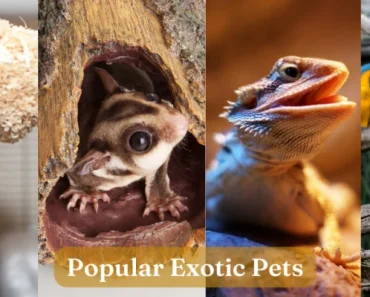Hummingbirds are unique and beautiful birds! I would definitely love to have a pet hummingbird but I understand that what I want may not be what’s best for the birds.
Pet hummingbirds would be very popular among bird owners, but there are two reasons that you can’t have a hummingbird as a pet.
So let’s get into why you can’t have pet hummingbirds and why it wouldn’t be a great idea even if they were legal to have as pets.
Can You Have a Pet Hummingbird?
Hummingbirds are wild and native bird species that are protected under the Migratory Bird Treaty Act of 1918 like most other wild birds. This act prohibits you from capturing, killing, trading, and transporting all native bird species and includes all of North America.
Under this Act, it is illegal to have a pet hummingbird and fines can get pretty hefty if you are caught keeping a hummingbird as a pet.
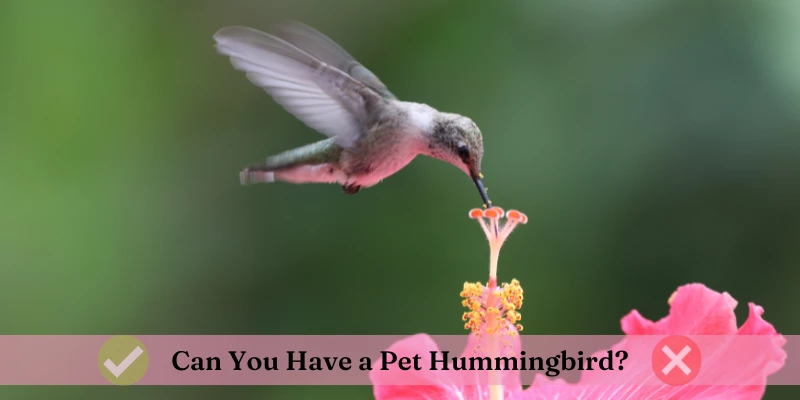
Can You Have a Pet Hummingbird in The United States (U.S.)?
Since hummingbirds are protected under the Migratory Bird Treaty Act, which prohibits people from owning pet hummingbirds, it is absolutely illegal to keep a hummingbird as a pet in the United States.
The Migratory Bird Treaty provides protection for any and all native bird species found within the United States.
Can You Have a Pet Hummingbird in Canada?
In Canada, hummingbirds are also under the Migratory Bird Treaty Act – prohibiting you from owning a pet hummingbird – just like in the United States since both countries fall under this Act.
The Migratory Bird Treaty Act covers any and all native bird species found in North America that are native to the states and countries within North America.
Can You Have a Pet Hummingbird in Australia?
Australia does not have any native hummingbirds so it would be virtually impossible to keep a pet hummingbird in Australia. Hummingbirds are found in the Americas and surrounding regions, but none are native to Australia.
It would be nearly impossible to import a pet hummingbird into Australia due to their laws and the fact that the hummingbird would likely die in transit due to how delicate and fragile these little birds can be.
Can You Have a Hummingbird as a Pet in The United Kingdom (UK)?
There are no native species of hummingbirds found in the wild in the UK. Due to this and the fragile nature of these birds, you will not be able to keep a pet hummingbird in the United Kingdom.
Hummingbirds are too fragile and don’t fare well in captivity and in enclosures, so transporting them to other countries and regions is nearly impossible.
18 Popular & Common Species of Hummingbirds
Over 330 different species of hummingbirds exist in the world with all of the different species of hummingbirds located in the Americas and outlying areas.
Around half of the hummingbird species live close to the equator and all are found in the Western Hemisphere.
Let’s take a look at some of the common hummingbird species.
1. Anna’s Hummingbird
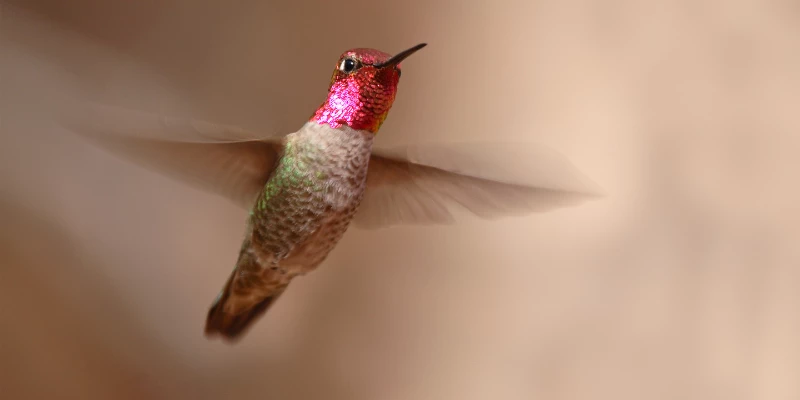
Anna’s hummingbirds are commonly found on the Pacific Coast. They are stocky in size and have rose-pink throats (males) and crowns.
Females tend to be a metallic green color with reddish-pink feathers found on their throats.
Anna’s hummingbirds don’t always migrate south for the winter considering the climate on the Pacific Coast.
They are one of the only hummingbird species that stay through the winter when other hummingbird species start their migration south.
2. Allen’s Hummingbird
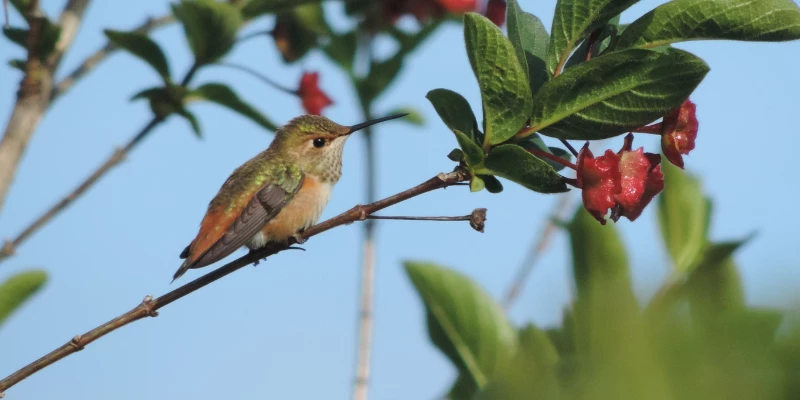
Allen’s hummingbirds have a green back and a rufous tail. Allen’s hummingbird males have a reddish-orange throat.
During the summer months, they are located along the coastal areas of Oregon and California and have two separate sub-species (Selasphorus and Sasin sasin), and spend the majority of the winter in Mexico.
Allen’s hummingbird males and females have separate habitats during mating season.
The males will keep a territory overlooking open areas while females prefer dense vegetation and forests to set up their nests after mating.
3. Berylline Hummingbird
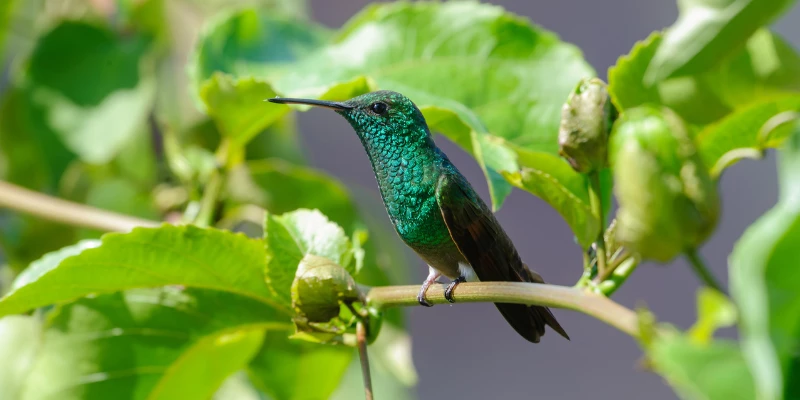
Berylline hummingbirds are common in Mexico and Central America but do travel to the United States, although they are mainly non-migratory birds.
They are medium-sized hummingbirds with males being slightly larger than females.
They sport colors of turquoise-green on their heads, throat, and chest with red wings and tails.
Berylline hummingbirds are solitary birds aside from mating season. They don’t typically live with other hummingbirds and don’t migrate in flocks.
They prefer habitats consisting of pine-oak trees, forests, and thickets. Berylline hummingbirds can be found near streams and at elevations above 3,000 feet.
4. Black-Chinned Hummingbird
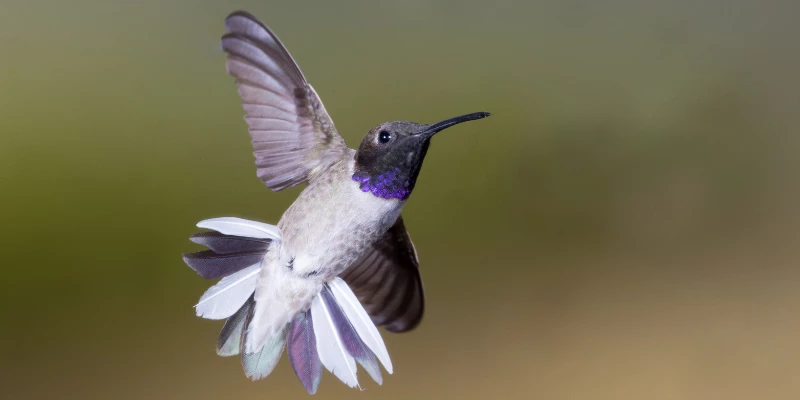
Black-chinned hummingbirds are typically found in deserts and mountainous forests but they occupy a wide range of habitats and are widespread from western Canada down to northern Mexico.
They are green in color with black chins that have a purple or violet stripe bordering the chin for males and white to whitish-gray throats for females.
Their diet consists of mostly insects and nectar.
Black-chinned hummingbirds are found in the West and are closely related to ruby-throated hummingbirds.
They migrate to southern Arizona, California, Texas, and northern Mexico during the winter months.
5. Blue-Throated Hummingbird (Mountain Gem)
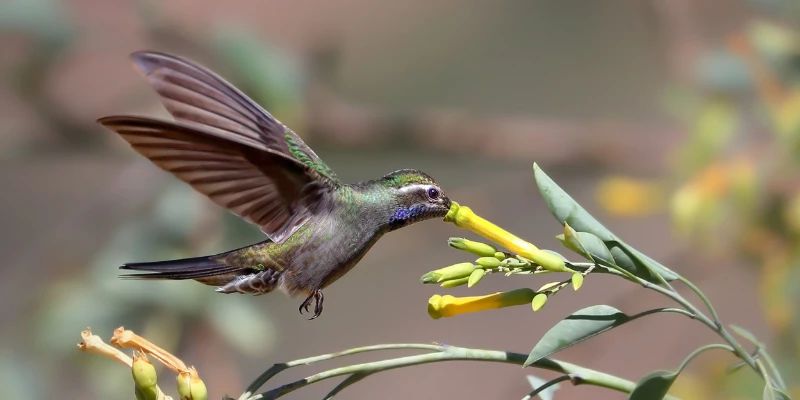
Blue-throated hummingbirds are one of the largest hummingbird species that can be found in the United States.
They are found mostly in mountainous regions in southern Arizona, New Mexico, Texas, and northern Mexico.
Blue-throated hummingbirds have (you guessed it) a blue throat along with a decurved beak, a full tail, and long wings.
The blue-throated hummingbird is also known as the blue-throated mountain gem due to its mountain habitats.
6. Broad-Billed Hummingbird
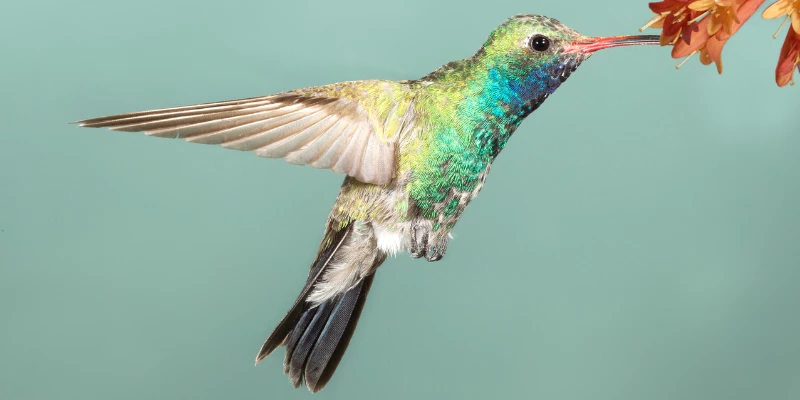
Broad-billed hummingbirds have long and straight red bills with emerald-colored bodies and sapphire throats.
They are very common during the summer months in southern Arizona when breeding season is in effect.
When it isn’t the mating season, broad-billed hummingbirds are typically found in western to northern Mexico.
Broad-billed hummingbird males tend to have fuller dark tails than females and have rounded corners on their tails.
Males also have a deep-blue throat while females tend to have a white eye stripe.
7. Broad-Tailed Hummingbird
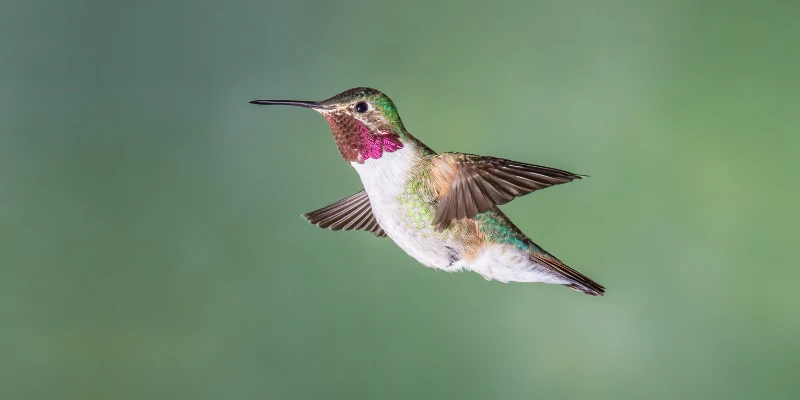
Broad-tailed hummingbirds are medium-sized hummingbirds that have white chests and lines down their bellies.
They have big heads and rose-magenta throats (males) with fluffy, green flanks.
Females have throats with green spots along with green spots on their cheeks. Broad-tailed hummingbirds have bodies that are slender and also have long straight bills.
Broad-tailed hummingbirds are found in meadows with high elevation, forests and forest openings, and near shrubby habitats around pine-oak and oak woodlands.
8. Buff-Bellied Hummingbird
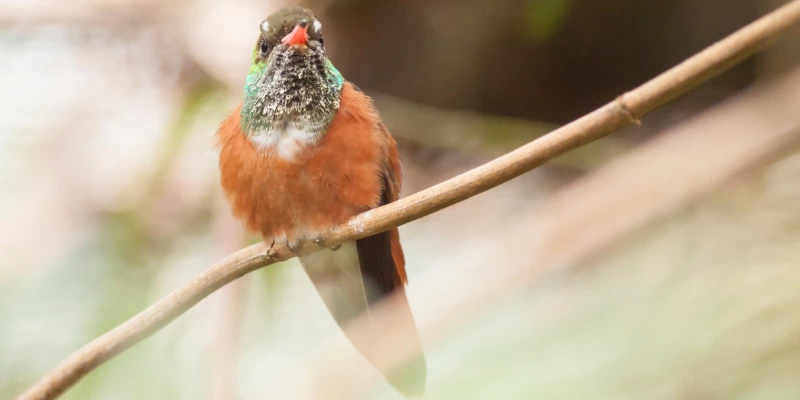
Buff-bellied hummingbirds are green with buff bellies, red bills with black tips, and bluish-green throats and breasts.
Their habitats (woodlands, gardens, dense thickets, and brushy areas) can be found along the Mexico and United States border in Texas and Louisiana.
They spend the summer months in Texas and migrate to Louisiana in the winter.
This is unique because most hummingbirds go south for the winter if they migrate and are not on a northern trajectory.
A buff-bellied hummingbird’s diet consists mainly of insects and nectar.
9. Calliope Hummingbird
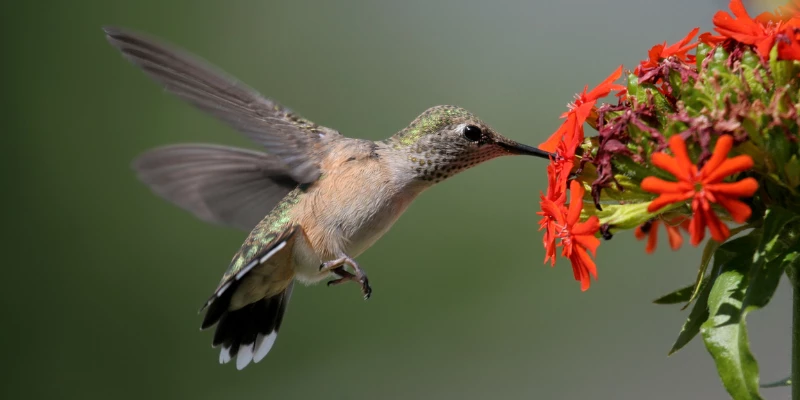
Calliope hummingbird males have magenta rays on their throats while females have mostly white necks. Males and females have green backs with short wings and tails.
They are one of the smallest hummingbird species that can be found in the United States and Canada.
Calliope hummingbirds have hunched postures that make them look even smaller than they really are. Their wings barely extend past their tails and they have thin, short bills.
10. Costa’s Hummingbird
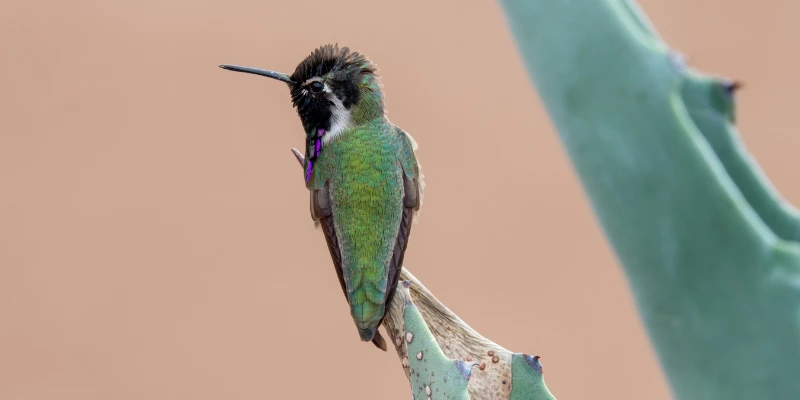
Costa’s hummingbirds are small and compact with a hunched posture. They also have short tails and wings that barely extend past their tails (similar to Calliope hummingbirds).
Males have bright purple feathers on their throats that stick out on both sides. Females are typically green in color with white underbellies.
Costa’s hummingbirds can be found in habitats of desert scrub in the southern United States, and western Mexico.
Since they are small, they tend to be excluded from areas where other hummingbird species live and must find their own secluded habitats.
11. Green-Breasted Mango Hummingbird
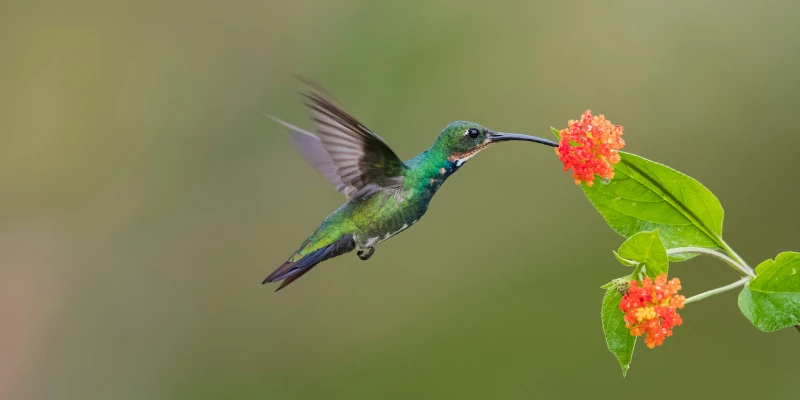
Green-breasted mango hummingbirds are large and bulky with a slightly arched black bill. Males are usually dark green in color with purple tails.
Females have dark stripes down the center of their throats and bellies and have white on the corners of their tails.
Green-breasted mango hummingbirds live in habitats on forest edges and also love open areas that have lots of scattered trees.
They can be found near forest edges and tropical lowlands in the United States and northeastern Mexico.
12. Lucifer Hummingbird
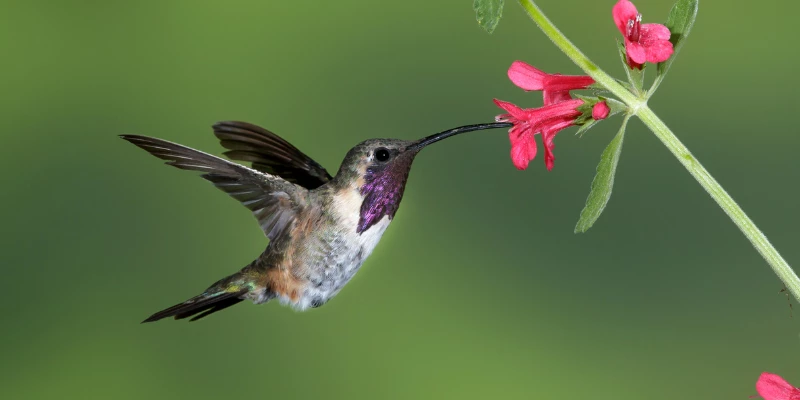
Lucifer hummingbirds are small hummingbirds that have curved bills and long, narrow tails. Males have purple throats and green backs.
Females are also green but have white necks and whitish to cinnamon underbellies. Females tend to have shorter tails than males do.
Lucifer hummingbirds are mainly found in central and northern Mexico in dry canyons and hillsides.
In the summer months, they can be found in the United States in southeastern Arizona and Texas.
13. Mexican Violetear Hummingbird
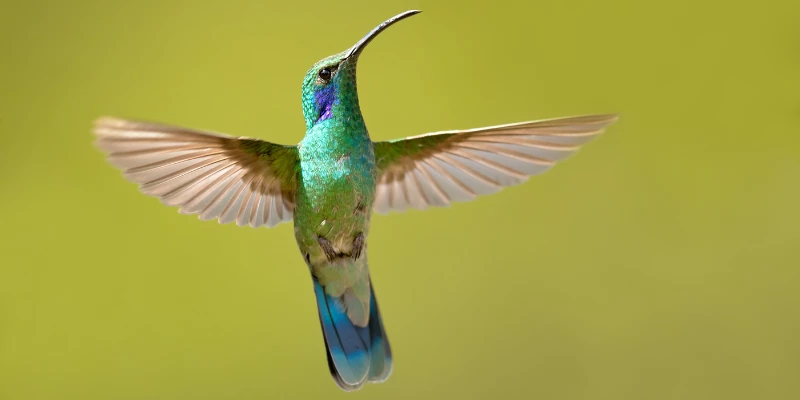
Mexican violetear hummingbirds are an overall bright green color. They have violet-blue ear patches and a slightly down-curved bill.
Males have bronze colors on the upper parts of their tales.
Mexican Violetear hummingbirds can be found in tropical areas and highlands in southern to central Mexico and in Central America.
Their habitats consist of semi-open areas on forest edges and clearings where there are trees and shrubs.
They are rare sights to see in the United States but some have been spotted as far north as southern Canada.
14. Rivoli’s Hummingbird
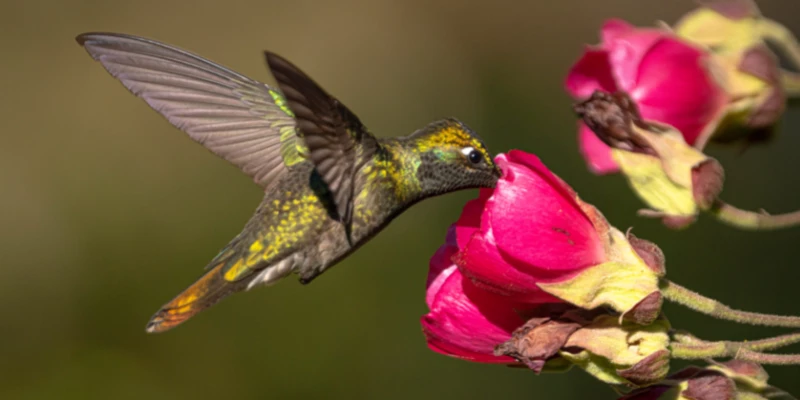
Rivoli’s hummingbirds are a larger and darker hummingbird species with purple crowns and emerald-colored throats.
They set up their habitats in mountainous regions that have pine-oak trees and also can be found near canyons in Nicaragua and the southwestern United States.
Rivoli’s hummingbirds typically get along with other hummingbird species around bird feeders and flowers.
These hummingbirds were also known as Magnificent Hummingbirds from 1983 to 2017 but were renamed the Rivoli’s Hummingbird when the two species split.
The second species was renamed the Talamanca Hummingbird.
15. Ruby-Throated Hummingbird
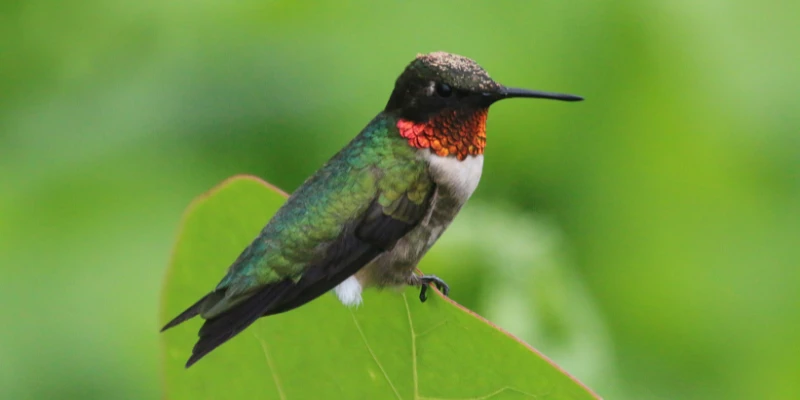
Ruby-throated hummingbirds have emerald or green on their backs, crowns with white and grayish underbellies, and black bills.
Males have ruby red throats and black heads while females have white to dirty-white necks and underbellies.
Ruby-throated hummingbirds are small, slender hummingbirds that can be found in open areas, forest edges, grasslands, meadows, and gardens.
They are distributed throughout the east and middle parts of the United States (some in southern Canada) during the breeding season and can be found in Central America during the winter months.
16. Rufous Hummingbird
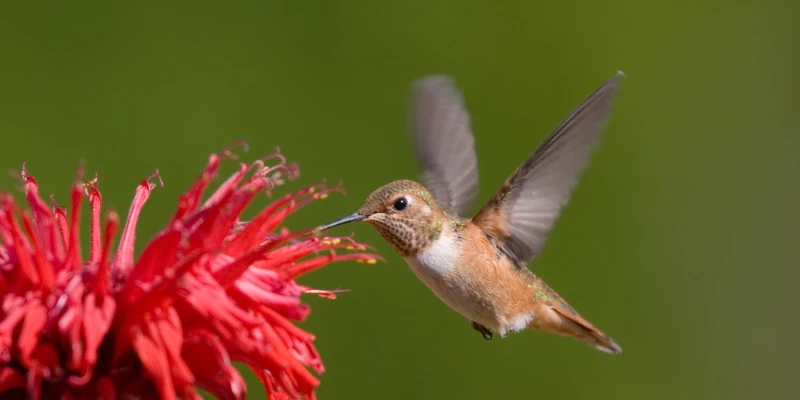
Rufous hummingbird males have bright orange on their backs and bellies with most having a red throat while females are green with green tails and maybe a spot of orange on their throats.
Rufous hummingbirds are found breeding in open areas, backyards, parks, and forest edges.
During the winter months, their habitats can be found in Mexico at middle to high elevations in shrubby areas and pine-oak forests.
17. Violet-Crowned Hummingbird
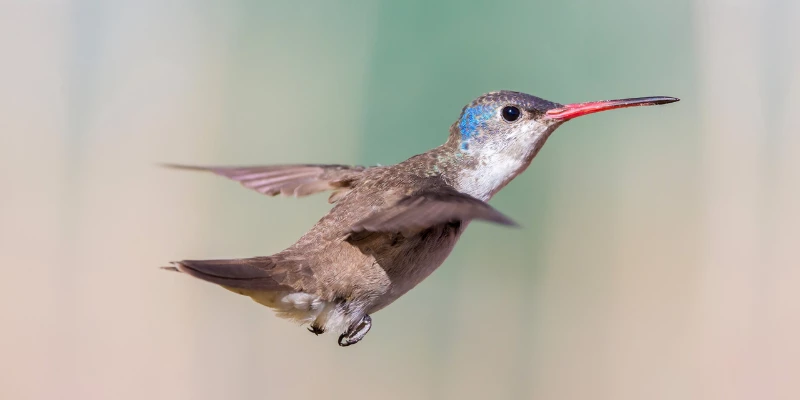
Violet-crowned hummingbirds have violet-purple crowns that glitter along with longer, red bills and white underbellies.
Males don’t have any significant throat patches or colors and typically have white throats.
Violet-crowned hummingbirds are found in Mexico with not many of the species venturing up to the southeastern United States.
However, the birds that are found in the U.S. tend to stay year-round and don’t migrate like the others.
They like canyons at middle elevations and prefer sycamore trees in their habitats.
18. White-Eared Hummingbird
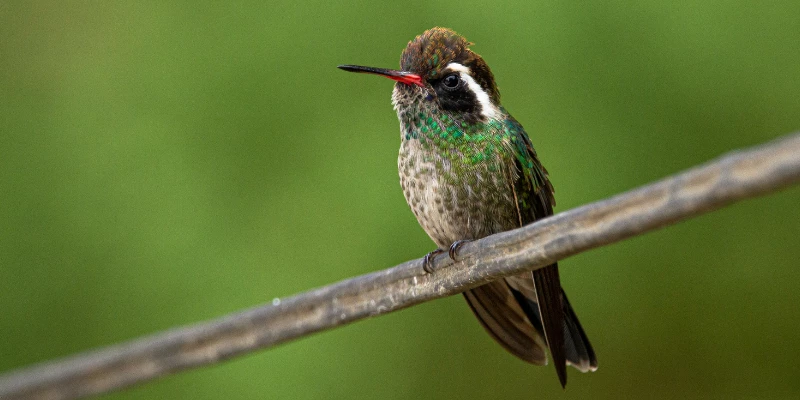
White-eared hummingbirds are another uncommon visitor to the southern United States similar to violet-crowned hummingbirds.
They have white ears, darker heads, green backs, and red bills with black tips.
White-eared hummingbirds are commonly widespread in Mexico and Central America.
They can be found in clearings and forest edges in higher mountain ranges and prefer pine-oak trees at middle elevations.
Some can be found in the United States in southern Arizona around canyons if they find a hummingbird feeder that suits them.
Are Hummingbirds Good Pets?
Hummingbirds are not good pets because having a pet hummingbird is illegal. Hummingbirds are included in the Migratory Bird Treaty Act of 1918 and are not allowed as pets no matter where you live.
I would love to have a pet hummingbird but there are reasons these laws exist.
Keeping a hummingbird as a pet would not be a good idea considering hummingbirds need to constantly be flying when they are not at rest or asleep – and you would need to have accommodations for that.
Accommodations would need to include a large enclosure where your pet hummingbird would have the ability to fly around all the time.
But in all honesty, the claims are that a hummingbird would die in captivity because they are not physically built to be held captive.
Based on everything I know about hummingbirds, I agree with those claims and would not own a pet hummingbird because of how cruel it could be.
It is best to admire these beautiful birds in their natural habitat and attract them to your yard where you can enjoy their company if you really want to have hummingbirds around your place.
Hummingbird Physical Details
With over 300+ different species of hummingbirds, they can all vary in physical description.
Most are small in size, many are colorful, and they can be found throughout the United States, Mexico, Central America, and other regions.
The majority of hummingbird species measure between 3 to 5 inches in length and weigh less than an ounce.
The largest of the hummingbird species is the Giant Hummingbird, which can grow to a length of up to 9 inches and weigh between 0.6 to 0.9 ounces.
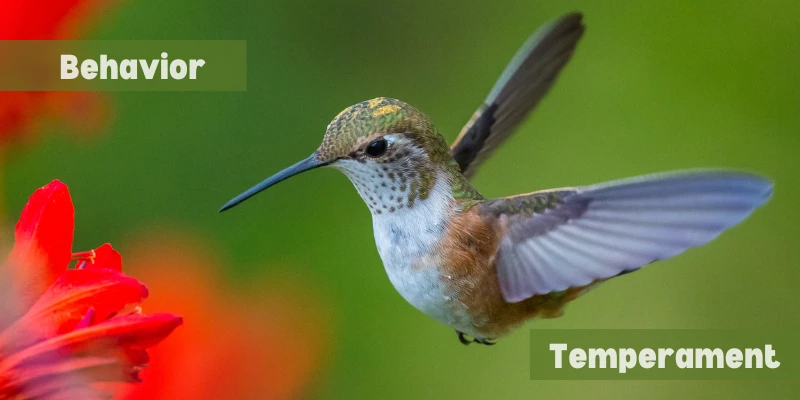
Hummingbird Behavior & Temperament
Below are some questions that I have answered about the behavior and temperament of hummingbirds to give you a better understanding of how these cute little birds operate.
Are Hummingbirds Aggressive?
Hummingbirds won’t usually become aggressive to a human. However, hummingbirds can be aggressive to other hummingbirds when it comes to food and flowers, and during the breeding season.
Are Hummingbirds Dangerous?
Hummingbirds aren’t typically dangerous to humans. They do have long, sharp beaks that could cause some damage but they don’t usually attack humans.
If they feel threatened, they would prefer to fly away rather than try to attack you.
Are Hummingbirds Affectionate?
Hummingbirds can grow attached to a human and may even perch on your finger if they feel comfortable enough and not threatened.
If they are not scared, hummingbirds can grow quite comfortable being around you and may even greet you with a song.
Are Hummingbirds Friendly?
Hummingbirds can be friendly if they’ve been around you before and recognize that you are the one refilling their hummingbird feeder.
You may even get one to eat out of the palm of your hand if you can be patient and learn how to not startle the birds.
Are Hummingbirds Solitary?
Some species of hummingbirds join together in flocks to migrate south for the winter but the majority are solitary birds that only come together with a partner during the breeding season.
Are Hummingbirds Territorial?
Males hummingbirds are especially aggressive and territorial when hunting for new territory.
They will chase away intruders by charging at them and directing the intruders away from the feeding area or nest.
What do Hummingbirds Eat?
The majority of hummingbird species eat insects, insect eggs, small spiders, and nectar – including sugar water in bird feeders.
Insects provide hummingbirds with the protein and fat they need while nectar gives the hummingbirds the energy they need for their higher metabolisms.
Hummingbird Habitat
Check out where hummingbirds live in the wild and what you would need for a captive hummingbird if you could have one as a pet.
Hummingbird Habitat In the Wild
Hummingbirds live in a variety of habitats ranging from open areas, forest edges, canyons, mountainous regions, and near shrubs, and can even be found in your backyards and gardens.
The majority migrate south for the winter into Mexico and Central America, but some are non-migratory birds.
Pet Hummingbird Habitat
If you could have a pet hummingbird (which you can’t because it is illegal), then you would need a large enclosure because these little birds need to fly around when they are not resting or sleeping.
Pet hummingbirds would not be very popular among pet owners if they were legal because it is known that these little birds have a hard time in captivity and will die fairly quickly.
How Much Do Hummingbirds Cost?
Hummingbirds don’t cost anything since you can’t purchase a pet hummingbird because it is illegal to own a hummingbird as a pet.
If someone is attempting to sell you a pet hummingbird, best believe that it is an illegal transaction no matter where you live in the United States or elsewhere.
Having a pet hummingbird is illegal everywhere!
It is best to let these little birds be in nature because that is where they thrive.
Even if you could have a pet hummingbird, it still wouldn’t be a good idea to keep one as a pet because it is virtually impossible to keep one alive in captivity.
33 Commonly Asked Questions About Hummingbirds
Below are 33 commonly asked questions with answers that we see about hummingbirds on a regular basis.
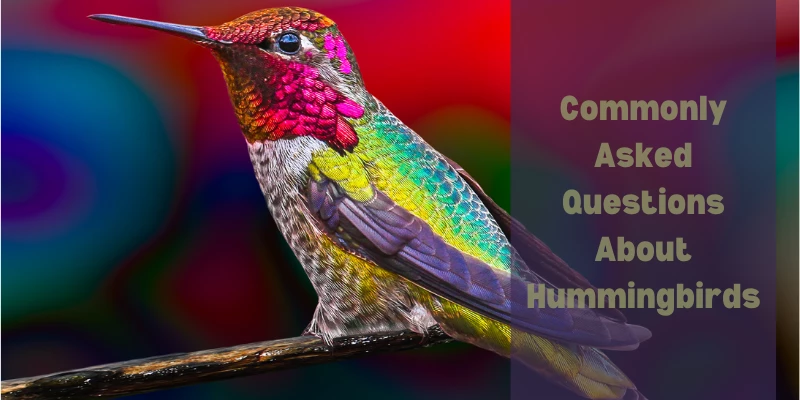
1. Can Humming Birds Be Tamed?
It depends on what you mean by tame. Will you ever own a pet hummingbird? No!
But hummingbirds can get comfortable with being around you if you are very patient with them.
A hummingbird may even eat out of your hand if you can be very still and not startle the bird after it has become comfortable around you.
That is about as close as you can get to having a pet hummingbird.
2. Can a Hummingbird Hurt You?
Hummingbirds have long and sharp beaks but usually don’t attack humans.
When they do attack humans, they don’t really do any damage enough to actually hurt you, but you do need to watch out for their beaks.
3. Why Are Hummingbirds Illegal?
Hummingbirds are illegal because they fall under the Migratory Bird Treaty Act of 1918.
But another reason they would be illegal even if they didn’t fall under this Treaty is that they are very fragile birds and don’t do well in captivity.
4. Can You Train a Hummingbird?
I’d say it is actually the other way around. You need to train yourself to be around a hummingbird.
If you really want to get a hummingbird to like you, you need to be very still and make no sudden movements when around them.
Eventually, you may even get a hummingbird to land on your shoulder or in your hand.
So, it would be like having a pet hummingbird, but only when your new friend wants to come around and visit you.
5. Can a Pet Hummingbird Live in Captivity?
Hummingbirds constantly need to be flying. It is illegal to keep a hummingbird as a pet.
If it was legal, it would be difficult to keep a pet hummingbird because they have a constant need to fly and would die if not able to do so.
6. Do Hummingbirds Scare Easily?
Yes, hummingbirds can scare easily (especially adult females). The key to being around a hummingbird successfully is to not make any sudden movements and allow the hummingbird to come to you.
7. Will a Hummingbird Eat from Your Hand?
You can try to feed a hummingbird with a handheld feeder after they have visited you for a while and grown comfortable with you.
You will need to be patient because it may take a minute for your “pet” hummingbird to warm up to you.
8. Is It Okay to Touch a Hummingbird?
There are no laws in place that make touching a hummingbird illegal. You shouldn’t cause a hummingbird any pain or discomfort by touching it.
However, you should never trap a hummingbird and you should never try to keep a pet hummingbird.
9. Can You Touch Hummingbird Babies?
As with adults, there is no law stating you can’t touch a hummingbird baby. However, be gentle because a hummingbird baby is fragile.
10. What Are Hummingbird Babies Called?
As with many other birds, a hummingbird baby is actually called a “chick”. Other terms used for hummingbird babies include hatchling and nestling.
11. How Can You Tell the Difference Between Male & Female Hummingbirds?
Male hummingbirds have bright colors (green and orange) and bright red throats, orange backs, and bellies. Female hummingbirds have a spot of orange on their throats with green on their backs.
12. Are Hummingbirds Poisonous?
No, hummingbirds are not poisonous or venomous but may carry disease.
13. Do Hummingbirds Carry Diseases?
Some hummingbirds can carry salmonella that has the ability to spread when using hummingbird feeders.
14. What Is the Lifespan of A Hummingbird?
The average lifespan of a hummingbird is between 3 to 5 years. Although on occasion some have been observed to live over 10 years.
15. How Do You Buy a Pet Hummingbird?
You can’t buy a pet hummingbird because hummingbirds are illegal to own as pets no matter where you live.
Even if you were able to purchase a pet hummingbird, it would prove very difficult to keep your new pet alive because of its constant need to fly.
16. Do Hummingbirds Bathe in Bird Baths?
Yes, hummingbirds will bathe in a birdbath just like other birds. They especially like birdbaths that have some type of water spray going on.
17. Are Hummingbirds Rare?
Hummingbirds are not necessarily rare but they are only found in the Western Hemisphere with around half the species found near the equator.
Although there are over 300 different species of hummingbirds, only about two dozen different species travel north to the U.S. and Canada every year.
18. Where Do Hummingbirds Sleep?
Hummingbirds will find a twig or small branch that is shielded from the wind at night and sleep there. They may also sleep down the side of a tree trunk or in heavy vegetation.
19. How Do Hummingbirds Sleep?
Hummingbirds don’t have any special sleep patterns except for sleeping upside down at times due to them being in deep sleep.
20. Do Hummingbirds Sleep Upside Down?
Not often but you can occasionally see a hummingbird sleeping upside down if they have entered a deep sleep known as “torpor”. This deep sleep helps hummingbirds conserve energy and survive harsh temperatures.
21. How Long do Hummingbirds Sleep?
Hummingbirds can sleep from 8 to 16 hours depending on the time of year and the location of the hummingbirds. They sleep at night and aren’t usually very active between dusk till dawn.
22. Do Hummingbirds Sing?
Yes, some hummingbirds have been known to burst out in singing. While they are no Whitney Houston, they can spit a tune or two. Anna’s hummingbird is known to sing quite a bit and more than other hummingbird species.
23. Do Hummingbirds Recognize Human Voices?
A hummingbird can recognize human voices and might even become fond of yours if your new “pet” hummingbird recognizes that you are the one stocking its feeder.
Hummingbirds have good memories and are typically very observant of their environments.
24. Do Hummingbirds Drink Water Without Sugar?
Yes, hummingbirds will drink water without sugar. It is a misconception that hummingbirds live on sugar water alone. While they enjoy sugar water and nectar, hummingbirds also feed on small insects and tree sap.
25. Do Hummingbirds Fly in The Dark?
Hummingbirds don’t typically fly in the dark at night. However, there are some exceptions. If they are in a well-lit area, they may fly around in the dark to feed. The only other time you will see hummingbirds fly at night is when they are migrating.
26. Do Hummingbirds Fly in The Rain?
Yes, hummingbirds have the ability to fly in the rain and some do. However, most hummingbirds will choose to seek shelter in thick vegetation or on the side of a tree trunk during heavy downpours.
27. Do Hummingbirds Have Predators?
Yes, hummingbirds have predators. Feral and domestic house cats will be the most common predator of hummingbirds around your house.
Other predators include larger birds, squirrels, snakes, frogs, and lizards if they have the ability to catch a hummingbird (which isn’t very often).
28. Do Hummingbirds Fly Backwards?
Technically, no. They can move backward in the air but this is more of a hover state rather than actually flying backward.
29. Are Hummingbirds the Only Birds that Can Hover?
Hummingbirds are the only birds in the world that actually hover. The wings of a hummingbird can be flapping anywhere from 20 to 80 times every second, which gives it the ability to hover, move forward and backward in the air, and move straight up and down in the air.
30. How Fast Can a Hummingbird Fly?
Hummingbirds flap their wings between 20 to 80 times per second and can fly at speeds between 20 to 30 miles per hour. Males will flap their wings even faster during displays of courtship.
31. Do Hummingbirds Fight?
Hummingbirds do fight on occasion. However, the fight typically consists of chases and vocalizations more than physical altercations. If there is a physical altercation, hummingbirds use their claws to grapple and fight.
32. What Type of Flowers Do Hummingbirds Like?
Hummingbirds love all types of flowers with bright colors. Some of their favorites include:
- Agastache
- Bee Balms
- Cardinal Flowers
- Catmints
- Coral Bells
- Daylilies
- Delphiniums
- Eastern Red Columbines
- Flowering Tobaccos
- Lupines
- Foxgloves
- Hollyhocks
- Honeysuckles
- Hosta
- Penstemons
- Red Hot Pokers
- Salvias
- Trumpet Vines
- Zinnias
33. What Are a Flock of Hummingbirds Called?
A flock of hummingbirds is commonly known as a bouquet, glittering, hover, shimmer, or tune of hummingbirds. But the most common term for a flock of hummingbirds is a charm.
Recap
Although you can’t have a pet hummingbird, you can still have a “pet” hummingbird. Since these beautiful little birds are illegal as pets, you can still be around them.
You just need to add flowers, bird feeders, and birdbaths to attract them to your yard.
Since hummingbirds will return to places they are familiar with, it will be like you have a pet hummingbird, just not in captivity.
In this article, I gave you all the information you’d really ever need on hummingbirds and having pet hummingbirds. I gave you all the legal mumbo jumbo and why hummingbirds can’t be pets.
I provided you with some of the most common types of hummingbirds, what they eat, where they sleep, and other general information.
I just love hummingbirds and welcome them to my yard. Although I can’t have a pet hummingbird, I still get to enjoy these beautiful birds in my back yard and you can too.
Give the tips in the article on how to attract hummingbirds a try and maybe you can have your own “pet” hummingbird too.
That is all I have on hummingbirds for now, but that was a lot. Check out more bird articles here!



